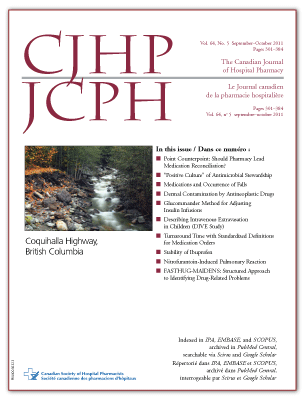Medications Prescribed and Occurrence of Falls in General Medicine Inpatients
DOI:
https://doi.org/10.4212/cjhp.v64i5.1066Keywords:
accidental falls, pharmaceutical preparations, inpatients, chutes accidentelles, préparations pharmaceutiques, patients hospitalisésAbstract
ABSTRACT
Background: Although falls are multifactorial, medications are a key risk factor that may be modifiable. Falls were among the most common occurrences entered into a risk identification system at the authors’ hospital.
Objectives: To identify whether general medicine inpatients who had experienced a fall were taking any medications known to be associated with falls.
Methods: The literature was reviewed to develop a list of high-risk medications that have been associated with falls. In a retrospective quality-improvement database-based study, information from the risk identification system was merged with data from the pharmacy dispensing system for general medicine inpatients who had experienced a fall. The primary end point was the percentage of patients with a documented fall who had a prescription for a high-risk medication. The number of such medications that had been prescribed for patients who fell was also calculated.
Results: Eighty-one unique medications were found to be associated with falls. During the study period (April 1, 2008, to March 31, 2009), 151 patients experienced a fall. Of those, 144 (95.4%) were taking at least one high-risk medication. The mean number of high-risk medications per patient who experienced a fall was 2.2. Of all documented falls, a new high-risk medication had been started within 7 days before the fall for 74 (49.0%) and within 24 h before the fall for 17 (11.3%). The most commonly prescribed drugs during all time periods (i.e., within 24 h or 7 days before the fall or since the patient’s admission) were lorazepam and zopiclone. The pharmacy database did not track administration of medications, so it is possible that some of the drugs prescribed were not actually taken by the patient.
Conclusion: Almost all inpatients who experienced a fall during the hospital stay had a prescription for at least one medication associated with a high risk for falls. Lorazepam and zopiclone were the drugs most commonly associated with falls in this hospital, and their use should be reviewed.
RÉSUMÉ
Contexte : Bien que la cause des chutes soit multifactorielle, les médicaments en sont un facteur de risque clé pouvant être modifié. Les chutes sont l’un des événements les plus fréquents saisis dans le système d’identification des risques à l’hôpital des auteurs.
Objectifs : Déterminer si les patients hospitalisés en médecine générale qui ont subi une chute prenaient des médicaments reconnus pour être associés aux chutes.
Méthodes : On a effectué une revue de la littérature pour établir une liste des médicaments à haut risque associés aux chutes. Une étude rétrospective fondée sur une base de données visant l’amélioration de la qualité a fusionné les données tirées du système d’identification des risques aux données issues du système de distribution de la pharmacie portant sur les patients hospitalisés en médecine générale ayant subi une chute. Le paramètre d’évaluation principal était le pourcentage de patients ayant subi une chute constatée à qui l’on avait prescrit un médicament à haut risque. Le nombre de médicaments à haut risque ayant été prescrits aux patients qui avaient subi une chute a également été calculé.
Résultats : On a dénombré 82 médicaments différents associés à des chutes. Durant la période de l’étude (du 1er avril 2008 au 31 mars 2009), 151 patients ont subi une chute. De ceux-ci, 144 (95,4 %) prenaient au moins un médicament à haut risque. Le nombre moyen de médicaments à haut risque par patient ayant subi une chute était de 2,2. De tous les cas de chutes consignés, on avait commencé à administrer un nouveau médicament à haut risque dans les sept jours précédant la chute chez 74 (49,0 %) des patients et dans les 24 heures avant la survenue de la chute chez 17 (11,3 %) des patients. Les médicaments les plus souvent prescrits pour toutes les périodes de temps (c.-à-d. moins de 24 heures ou de sept jours avant la chute ou depuis l’admission du patient) étaient le lorazépam et la zopiclone. La base de données de la pharmacie ne permet pas de savoir si les médicaments ont été réellement administrés et il est donc possible que certains des médicaments prescrits n’aient pas été pris par quelques patients.
Conclusion : Presque tous les patients ayant subi une chute durant leur hospitalisation avaient reçu une ordonnance d’au moins un des médicaments associés à un risque élevé de chute. Le lorazépam et la zopiclone étaient les médicaments les plus souvent associés à des chutes dans cet hôpital et leur utilisation devrait donc être examinée.
Downloads
Published
Issue
Section
License
Copyright © Canadian Society of Healthcare-Systems Pharmacy.
After publication of a manuscript in the CJHP, the authors of the manuscript must obtain written permission from the CSHP (publications@cshp.ca) before reproducing any text, figures, tables, or illustrations from the work in future works of their own. If a submitted manuscript is declined for publication in the CJHP, all said rights shall revert to the authors. Please note that any forms (e.g., preprinted orders and patient intake forms) used by a specific hospital or other health care facility and included as illustrative material with a manuscript are exempt from this copyright transfer. The CJHP will require a letter from the hospital or health care facility granting permission to publish the document(s).










